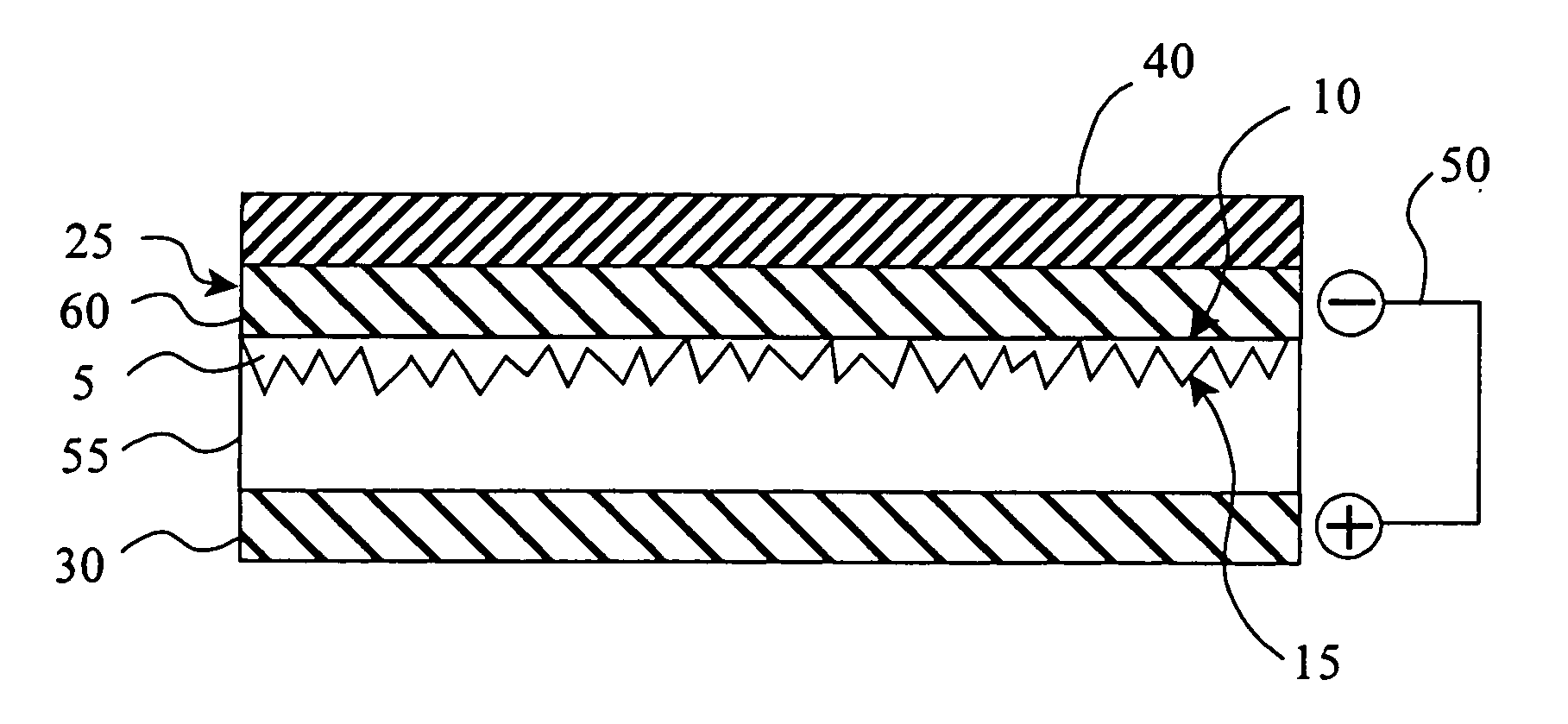Amorphous diamond materials and associated methods for the use and manufacture thereof
a diamond-like carbon material and diamond-like technology, applied in the direction of discharge tube luminescence screen, manufacturing tools, drinking vessels, etc., can solve the problems of limiting the potential use the failure of the field emission device to achieve the effect of optimizing the luminescence, and the failure of the field emission device to achieve the effect of reducing the cost of the devi
- Summary
- Abstract
- Description
- Claims
- Application Information
AI Technical Summary
Benefits of technology
Problems solved by technology
Method used
Image
Examples
example 1
[0095] An amorphous diamond material was made as shown in FIG. 3, using cathodic arc deposition. Notably, the asperity of the emission surface has a height of about 200 nanometers, and a peak density of about I billion peaks per square centimeter. In the fabrication of such material, first, a silicon substrate of N-type wafer with (200) orientation was etched by Ar ions for about 20 minutes. Next, the etched silicon wafer was coated with amorphous diamond using a Tetrabond® coating system made by Multi-Arc, Rockaway, N.J. The graphite electrode of the coating system was vaporized to form an electrical arc with a current of 80 amps, and the arc was drive by a negative bias of 20 volts toward the silicon substrate, and deposited thereon. The resulting amorphous diamond material was removed from the coating system and observed under an atomic force microscope, as shown in FIGS. 3 and 4.
[0096] The amorphous diamond material was then coupled to an electrode to form a cathode, and an ele...
example 2
[0097] A 10 micron layer of copper can be deposited on a substrate using sputtering. Onto the copper was deposited 2 microns of samarium by sputtering onto the copper surface under vacuum. Of course, care should be taken so as to not expose the beryllium to oxidizing atmosphere (e.g. the entire process can be performed under a vacuum). A layer of amorphous diamond material can then be deposited using the cathodic arc technique as in Example 1 resulting in a thickness of about 0.5 microns. Onto the growth surface of the amorphous diamond a layer of magnesium can be deposited by sputtering, resulting in a thickness of about 10 microns. Finally a 10 microns thick layer of copper was deposited by sputtering to form the anode.
example 3
[0098] A 10 micron layer of copper can be deposited on a substrate using sputtering. Onto the copper was deposited 2 microns of cesium by sputtering onto the copper surface under vacuum. Of course, care should be taken so as to not expose the cesium to oxidizing atmosphere (e.g. the entire process can be performed under a vacuum). A layer of amorphous diamond material can then be deposited using the cathodic arc technique as in Example 1 resulting in a thickness of about 65 nm. Onto the growth surface of the amorphous diamond a layer of molybdenum can be deposited by sputtering, resulting in a thickness of about 16 nm. Additionally, a 20 nm thick layer of In-Sn oxide was deposited by sputtering to form the anode. Finally, a 10 micron layer of copper was deposited on the In-Sn layer by sputtering. The cross-sectional composition of the assembled layers is shown in part by FIG. 9A as deposited. The assembled layers were then heated to 400° C. in a vacuum furnace. The cross-sectional c...
PUM
| Property | Measurement | Unit |
|---|---|---|
| thick | aaaaa | aaaaa |
| thick | aaaaa | aaaaa |
| thick | aaaaa | aaaaa |
Abstract
Description
Claims
Application Information
 Login to View More
Login to View More - R&D
- Intellectual Property
- Life Sciences
- Materials
- Tech Scout
- Unparalleled Data Quality
- Higher Quality Content
- 60% Fewer Hallucinations
Browse by: Latest US Patents, China's latest patents, Technical Efficacy Thesaurus, Application Domain, Technology Topic, Popular Technical Reports.
© 2025 PatSnap. All rights reserved.Legal|Privacy policy|Modern Slavery Act Transparency Statement|Sitemap|About US| Contact US: help@patsnap.com



